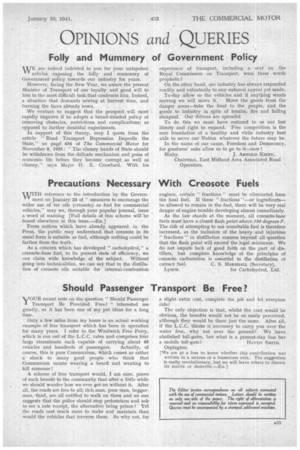Precautions Necessary With Creosote Fuels
Page 25

If you've noticed an error in this article please click here to report it so we can fix it.
WITH reference to the introduction by the Govern
ment on January 24 of " measures to encourage the wider use of tar oils (creosote) as fuel for commercial vehicles," may we, through your popular journal, issue a word of warning [Full details of this scheme will be found elsewhere in this issue.—ED.] From notices which have already appeared in the Press, the public may understand that creosote in its usual form is suitable as fuel, although nothing could be farther from the truth.
As a concern which has developed " carbohydrol," a creosote-base fuel, to its present state of efficiency, we can claim wide knowledge of the subject. Without going into technicalities, we can say that in the distillation of creosote oils suitable for internal-Combustion engines, certain " fractions " must be eliminated from the final fuel. If these " fractions "—or ingredients— be allowed to remain in the fuel, there will be very real danger of engine trouble developing almost immediately.
As the law stands at the moment; all creosote-base fuels must have a closed flash point above 150 degrees F. The risk of attempting to use unsuitable fuel is therefore increased, as the inclusion of the heavy and injurious " fractions " in distillation ensures beyond all question that the Hash point will exceed the legal minimum. We do not impute lack of good faith on the part of distillers, but complete knowledge of the principles of creosote carburation is essential to the distillation of
correct fuel. C. S. MARSHALL (Secretary), Ly/TIM. for Carbohydrol, Ltd.




















































